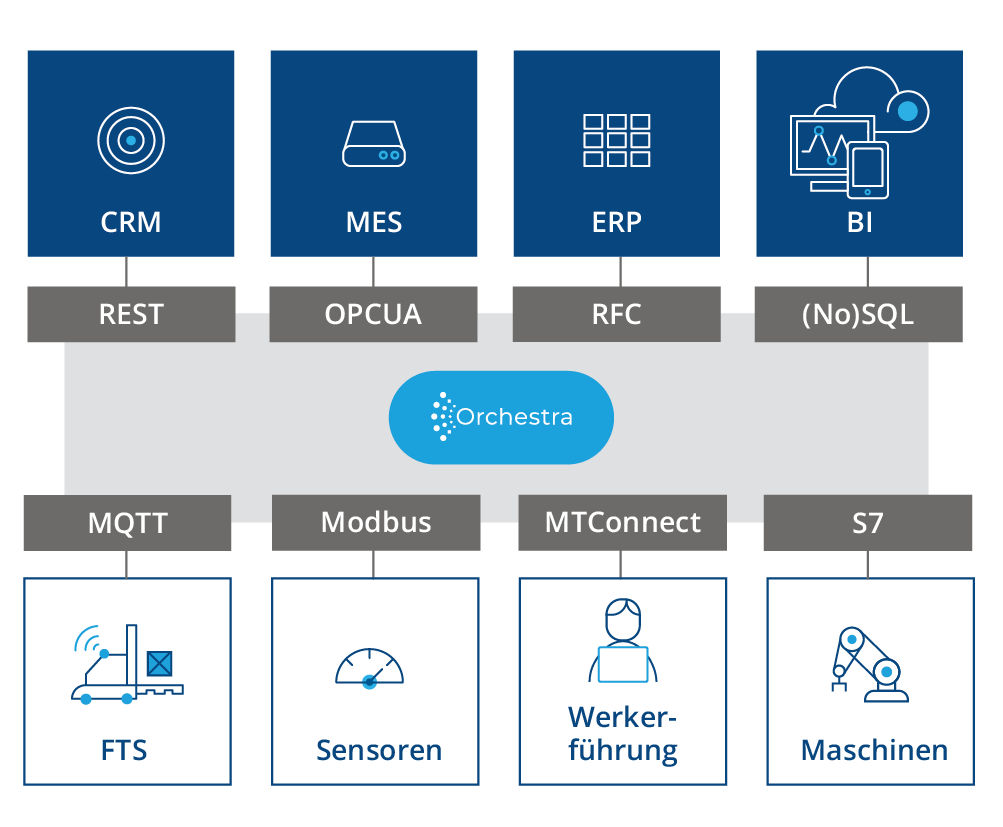Asset Administration Shell – Industry 4.0’s Standard for Connected Assets
Standardise equipment data, integrate assets plug-and-play, and enable flexible production workflows from shop-floor to cloud.

Orchestra enables Industry 4.0
The Asset Administration Shell is intended to provide a standard way to describe and manage physical assets such as machines, tools, and equipment in industrial environments. Without an administration shell, each machine would have to be individually and manually integrated for automation purposes. This is time-consuming, expensive, and error-prone – and not up to date with regard to Industry 4.0. The AAS pursues the goal of enabling automated integration through standardized asset descriptions on the part of manufacturers. It thus provides the basis for use cases such as Overall Equipment Effectiveness, Condition Monitoring, Predictive Maintenance and many more.
It is really impressive what soffico is getting off the ground: A topic as important for the digitalization of manufacturing as the Asset Administration Shell is discussed with top-class experts from research, industry and associations at soffico’s Industry Round Table.
What is an
Asset Administration Shell?
The Asset Administration Shell (AAS) is a data and information model used in the Industrial Internet of Things (IIoT) to describe and manage assets. The management shell is basically a data plug that allows to retrieve or store all relevant information about a specific asset, device, or component. It is considered an implementation of the Digital Twin concept and is thus a foundation for Industry 4.0. In this context, the AAS defines a data model for the description of assets, their relationships and the relevant data that must be recorded and stored for each asset. The goal of the AAS is to create a standard for describing and managing assets in an industrial environment that enables interoperability between different systems and improves the efficiency of asset management processes.
Hurdles & Challenges, that an Asset Administration Shell aims to solve
The Asset Administration Shell (AAS) was developed to take a step towards digitization – solving the following problems in managing industrial assets:
Orchestra – your enabler for successful AAS implementation
- A connectivity layer is an important component for the successful implementation of an Asset Administration Shell (AAS). This data integration layer is responsible for connecting different systems and devices in the industrial environment that data can be collected, stored, and analyzed. This data is used to manage assets and provide information about their performance and maintenance needs.
- The connectivity layer enables various systems and devices to communicate with each other and with the AAS, providing real-time information about the assets. This information is used for decision-making and enables companies to optimize their operations and reduce costs.

- Without a robust and reliable connectivity layer, the AAS would not be able to effectively manage assets and collect the data needed for decision making. Connectivity and data integration are critical components in implementing the AAS. The management shell must be designed and implemented to meet the specific requirements of each industry environment.
- In summary, the connectivity layer plays a critical role in the successful implementation of the Asset Administration Shell by enabling the collection, storage, and analysis of data in real time and providing the information needed for effective asset management and decision making.
Industry 4.0:
Benefits of the Administration Shell in Practice
On the road to the Smart Factory, the Asset Administration Shell (AAS) offers numerous benefits for industrial companies looking to improve the efficiency, reliability and transparency of their asset management processes:
Asset Administration Shell with Orchestra
Overall, the Asset Administration Shell aims to improve the efficiency and transparency of asset management in industrial environments, enable better decision-making and reduce costs.
With the help of the soffico middleware, the connected machines can also be directly and easily integrated into other processes, thus directly filling the basic AAS technology with life. With our low-code platform, we break down technical barriers and focus on content, not technical work. Get in touch with us!
Markus Benndorff

